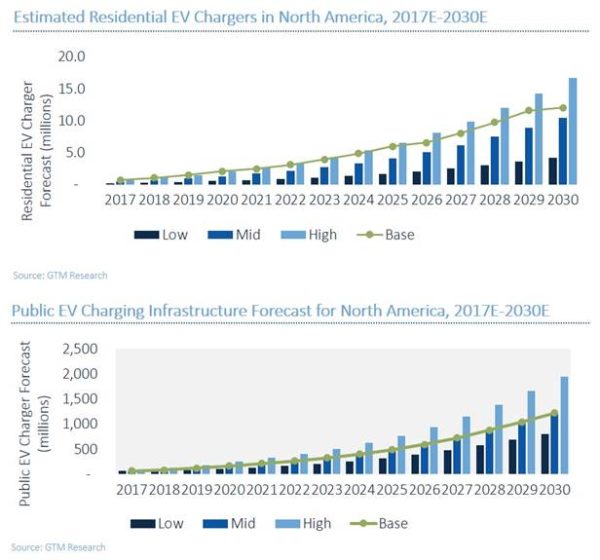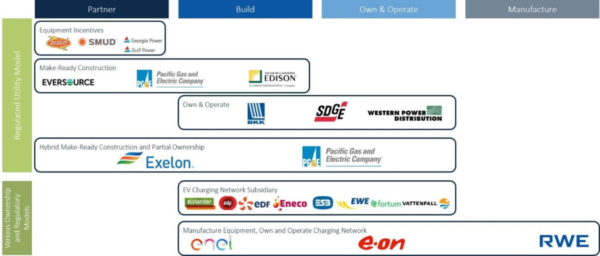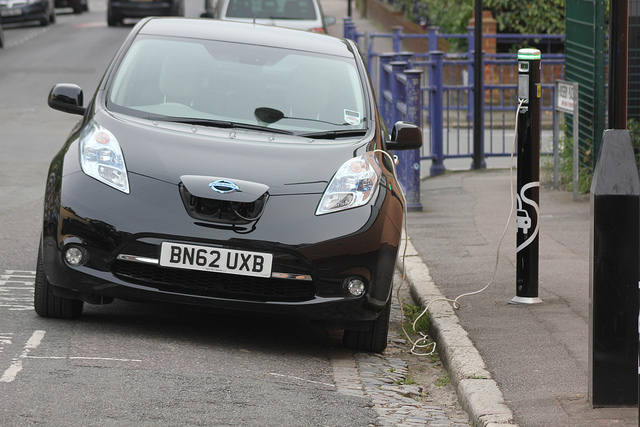In its latest report, GTM Research estimates that by 2030, the share of electric vehicles (EVs) in total new car sales will be 11%, up from currently around 3%. In comparison, BloombergNEF said earlier this year that it expects to see EVs comprising 28% of all new car sales by this time. By 2050, meanwhile, it predicts that 55% of new car sales will comprise EVs, thus resulting in 33% of the global car fleet being electric.
Charging infrastructure
As the market for EV’s is growing, so is the market for EV charging infrastructure. GTM Research states that the global EV charging infrastructure will reach 40 million charging points, also by 2030. Resulting from this large-scale infrastructure development, a range of stakeholders in the energy and grid operating business are collaborating, and developing new business models to participate in this growing market.

Graphic: GTM Research
Timotej Gavrilovic, lead author of the reports, comments, “The EV charging infrastructure ecosystem is very complex, and most projects require strong partnerships between both public and private stakeholders to deploy necessary infrastructure.”
EV charging infrastructure is becoming a serious business for many players along the value chain, and it is not yet determined who will participate, or take the most substantial chunk. A plethora of charging business models keeps the market highly competitive and dynamic.

Graphic: GTM Research
Annual market transactions for energy and delivery of grid services in North America is expected rise to $13 billion in 2030. This development is a result of different market models, like energy clouds or vehicle-to-grid solutions. At the same time, there is another market for equipment, installation, analytics and operational services for EV charging infrastructure projects opening. Over the course of the next two years, GTM Research estimates that the market will grow to $2.7 billion, and reach $18.6 billion by 2030.
The report further stipulates that in North America alone, there will be an additional 12 million residential charging points installed. In the European market, meanwhile, nine million EV chargers are set to be installed in private households. Looking at public chargers, GTM Research estimates that Europe will install 1.6 million, and North America around 1.2 million.
Inverters
For the residential market, a range of inverter suppliers has already assorted their product portfolios to include EV charging units to come with their solar inverters.
Many inverter suppliers have already prepared their offering to include EV chargers to meet this market. At the same time, there are myriad storage system suppliers and municipal utilities, which have established EV charging station business models. Such offerings would allow customers to, for example, feed solar PV generation from residential rooftops into the grids, and pay for EV charging at public charging points with the solar energy they have fed into the grid before.
This content is protected by copyright and may not be reused. If you want to cooperate with us and would like to reuse some of our content, please contact: editors@pv-magazine.com.




By submitting this form you agree to pv magazine using your data for the purposes of publishing your comment.
Your personal data will only be disclosed or otherwise transmitted to third parties for the purposes of spam filtering or if this is necessary for technical maintenance of the website. Any other transfer to third parties will not take place unless this is justified on the basis of applicable data protection regulations or if pv magazine is legally obliged to do so.
You may revoke this consent at any time with effect for the future, in which case your personal data will be deleted immediately. Otherwise, your data will be deleted if pv magazine has processed your request or the purpose of data storage is fulfilled.
Further information on data privacy can be found in our Data Protection Policy.